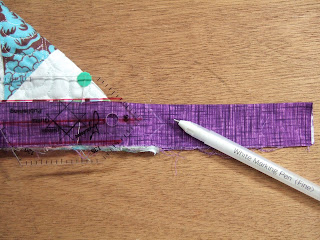Some of you have previously read my blog posts about my preferred binding method which is to machine sew those mitered corners, perfectly. For a complete tutorial, either click on the "Nine Quilt-y Tutorials" tab above, or go here.
When I considered how to put binding on this particular quilt, Snowflake Medallion, I knew I wanted it to be as perfect as I can make it. I'm entering it in our Iowa State Fair, August 11-21, and I've heard award-winning quilters say that judges really inspect the binding. So, after watching a Youtube binding video by award-winning quilter Sharon Schamber, I applied a couple of her tricks.
First, I starched my binding. I like to make homemade starch which is much less expensive than the aerosol type, and handy because I have a long-lasting jug of Sta-flo liquid starch. I follow a recipe offered by Mark Lipinski (see that recipe toward the bottom of my blog menu bar). I fill a spray bottle for use at my ironing table, and store the extra in the refrigerator.
Starch the binding between the folded layers so they stick together during handling.
I measured across the quilt. Adding 6" to that measurement, I cut two binding strips this length. (This is where the binding method begins to be different than the common method.)
Notice that I trimmed off the excess batting and backing before binding the quilt. My friends know that I prefer (and teach) to leave on the backing and batting until after the binding is sewn on.
I put a light bead of Elmer's School Glue along the edge of the quilt. Edited to add: Australians can find Elmer's School Glue at Officeworks.
Then I pressed to adhere the binding to the quilt. As Sharon Schamber states in her video, Elmer's School Glue is much like a very thick starch. I would agree. I liked that I didn't need to use pins to hold the binding in place while I sewed it to the quilt.
I glued, pressed and sewed to attach two separate binding strips to two opposite sides of the quilt. From the back, you can see that the sewing stops 1/4" from the edge of the quilt.
Then, I measured the quilt top again and cut two more binding strips to sew to the remaining opposite sides.
After sewing all four strips to the sides of the quilt, each corner looks just like this. You can see how the stitching just meets 1/4" from the quilt edges. Next I'll sew those two tails together with a mitered corner.
The quilt is folded at a 45-degree angle aligning the binding tails.
Using a Clover marking pen (white on purple fabric) I drew a 45-degree angle that marks where I need to sew.
Sewed and trimmed.
Turned inside out. Voila! It's the perfectly sewn mitered corner.
Once you know how to draw and sew one mitered corner, repeating that three more times is easy. Please refer to the tutorial for a complete explanation.
I used a blind stitch to "applique" the binding to the quilt back. I say applique because I've heard that to make the judges happy, hand stitches need to be close together. Mine are 1/4" to 3/8" apart.
Now I'll add quilted "beads" (circles) to the 1"-wide outside border. I could have done that earlier, but I was concerned that my quilting would land under the binding. Then, it will make me happy! I'll be finished with this project.
If you try binding this way - sewing binding strips to your quilt, and then machine sewing mitered corners - please let me know. I'd love to hear how it goes. Linda













Even better that your previous tutorial, I think I can do this. I'm willing to try on my next binding, I think that will be the cherries table runner...if we can just get the painting done!
ReplyDelete:-}pokey
Great explanation....and it looks perfect from here! I see a ribbon to match the binding in your future!!
ReplyDeleteI am SO excited to see this quilt in person!
ReplyDeleteHey Linda, very interesting way to bind, I am sure once you have done one all the other corners will fall into place. I am sure going to try that once I finish my next quilt. Actually I have a little mug rug maybe it would be good to try something new on. I will let you know. Blessings Sandra
ReplyDeleteSo lovely to Skype yesterday! Di B and I immediately watched the Sharon Schamber video tutorials you recommended for attaching the bindings this way and then ordered ourselves two bottles of Elmers on the Internet :-)) I really need to try your method of mitering corners now since mine look very sloppy in comparison. Maybe I should try it on a baby quilt. Such a clear tutorial - and I can't see how you won't win with Snowflake Medallion. Xx
ReplyDeleteThanks for the timely blog post. I have 5 quilts just back from the quilter & hadn't been looking forward to binding them. Now i'm wondering if i can buy a similar glue here in Aus. Happy Stitching,
ReplyDeleteGreat blog Linda. I remember being shown a similar method about 10....years or so ago, but haven't kept up doing it that way. Certainly looks NEAT which is what I like. Thanks for the reminder - must try it again.
ReplyDeleteLinda, this is so interesting! I've never seen anything like this. I'm definitely going to give it a try next time I bind a quilt! And the Elmer's School Glue is a great tip too. Thanks for sharing.
ReplyDelete